Slavkov – Battle of Austerlitz
By Tracy A. Burns
A famous battle and romantic chateau only a short journey from Brno
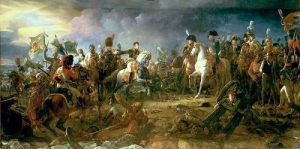 Perhaps best known for the Battle of Austerlitz fought several kilometers away during 1805 in what was then the Austrian Empire, Slavkov (better known as Austerlitz in English) boasts an astounding chateau as well as other monuments. One of the most romantic Baroque chateaus in Moravia, Slavkov features stunning ceiling frescoes and spectacular illusionary wall paintings as well as splendid artwork complemented by furnishings from various periods. It is best to take the tour that covers the entire first floor. Bus and train lines run regularly from Brno.
Perhaps best known for the Battle of Austerlitz fought several kilometers away during 1805 in what was then the Austrian Empire, Slavkov (better known as Austerlitz in English) boasts an astounding chateau as well as other monuments. One of the most romantic Baroque chateaus in Moravia, Slavkov features stunning ceiling frescoes and spectacular illusionary wall paintings as well as splendid artwork complemented by furnishings from various periods. It is best to take the tour that covers the entire first floor. Bus and train lines run regularly from Brno.
The Battle of Austerlitz
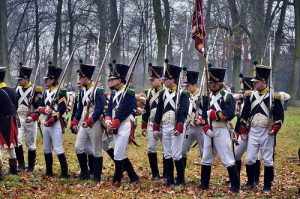 The Battle of Austerlitz (also called the Battle of the Three Emperors) took place on December 2, 1805, when French Emperor Napoleon I defeated a Russo-Austrian army headed by Tsar Alexander I and Holy Roman Emperor Francis II. After almost nine hours of intense fighting, the French triumphed. A truce was penned at the chateau on December 4. Later, on December 26, the treaty of Pressburg (Pozsany) called for Austria to cede lands in Italy, Bavaria, and Germany to France and her German allies. Not long thereafter the Holy Roman Empire came to an end, after Francis II abdicated in 1806.
The Battle of Austerlitz (also called the Battle of the Three Emperors) took place on December 2, 1805, when French Emperor Napoleon I defeated a Russo-Austrian army headed by Tsar Alexander I and Holy Roman Emperor Francis II. After almost nine hours of intense fighting, the French triumphed. A truce was penned at the chateau on December 4. Later, on December 26, the treaty of Pressburg (Pozsany) called for Austria to cede lands in Italy, Bavaria, and Germany to France and her German allies. Not long thereafter the Holy Roman Empire came to an end, after Francis II abdicated in 1806.
Monuments to the Battle of Austerlitz
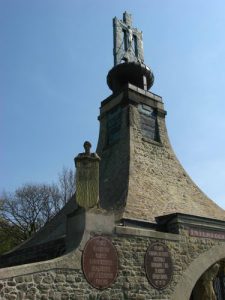 Near the town, visitors find many monuments to the Battle of Austerlitz. The 26-meter high Peace Memorial on Práce Hill consists of four female statues representing France, Austria, Russia, and Moravia. There is also a chapel, an ossuary, and a small museum. A Monument to the Three Emperors stands at The Old Vineyards near Blažovice, where the French and Russians had their bloody collision. The 18th century Old Post in Kovalavice, now housing a hotel and restaurant, was the location of French King of Naples and Marshall Joachim Murat’s headquarters in late 1805 and the place where Russian general Prince Pyotr Bagration stationed his headquarters during the legendary battle. Napoleon actually spent a night in this building. A granite monument on Žuráň hill shows where Napoleon had his army headquarters. Slapanice features a monument with mass graves. There is also a yearly reenactment of the battle carried out by performers in a historical dress on the anniversary of Napoleon’s birth, August 15. This mock battle takes place under Santon Hill, where there is a replica of a French Gribeauval cannon.
Near the town, visitors find many monuments to the Battle of Austerlitz. The 26-meter high Peace Memorial on Práce Hill consists of four female statues representing France, Austria, Russia, and Moravia. There is also a chapel, an ossuary, and a small museum. A Monument to the Three Emperors stands at The Old Vineyards near Blažovice, where the French and Russians had their bloody collision. The 18th century Old Post in Kovalavice, now housing a hotel and restaurant, was the location of French King of Naples and Marshall Joachim Murat’s headquarters in late 1805 and the place where Russian general Prince Pyotr Bagration stationed his headquarters during the legendary battle. Napoleon actually spent a night in this building. A granite monument on Žuráň hill shows where Napoleon had his army headquarters. Slapanice features a monument with mass graves. There is also a yearly reenactment of the battle carried out by performers in a historical dress on the anniversary of Napoleon’s birth, August 15. This mock battle takes place under Santon Hill, where there is a replica of a French Gribeauval cannon.
The chateau: from the 13th century through the Estates Uprising
The romantic chateau is a sight not to be missed. While the chateau was transformed into its current Baroque appearance from the end of the 17th century to the second half of the 18th century, it began as a mere fortress in the 13th century or earlier, when the Order of German Knights constructed it. The fortified settlement was transformed into a Renaissance chateau thanks to owner Petr, Count of Saint George and Pezinok, at the turn of the 15th and 16th centuries. In 1509 the chateau became the property of the Kounic (sometimes known as Kaunitz) clan. It would stay in their possession for more than four centuries. The chateau was not confiscated during the Estates Uprising of the early 17th century, resulting in the punishment of Protestant nobles who rebelled against the Catholic Habsburgs, because the Kounics associated with the chateau did not participate in the revolt.
From Baroque remodeling through the 19th century
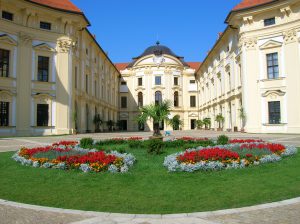 A judge in the Margrave of Moravia and later a minister in the Vienna State Council, Dominik Ondřej Kounic instigated the building’s Baroque remodeling with the services of Italian architect Domenico Martinelli of Lucca during the end of the 17th century. The well-renowned frescoes were completed by Andreas Lanzani around 1701. The garden was erected, too, with 15 hectares dotted by pools and fountains. Chamberlain to Emperor Charles VI at the Imperial Court and later a member of his secret service, Maximilián Oldřich continued to make changes to the chateau, but it was his successor, Prince of Kounic and Reitberg Václav Antonín, who finished the Baroque transition. A chancellor for four Habsburg rulers, he spent most of his time in Vienna, and many of the valuable pieces were moved there. Later, over 80 of the several hundreds of paintings at the chateau were taken by the celebrating French after the Battle of Austerlitz. Other valuables were sold during the beginning of the 19th century. When Václav Antonín died, the family’s importance decreased in terms of political influence and cultural contributions.
A judge in the Margrave of Moravia and later a minister in the Vienna State Council, Dominik Ondřej Kounic instigated the building’s Baroque remodeling with the services of Italian architect Domenico Martinelli of Lucca during the end of the 17th century. The well-renowned frescoes were completed by Andreas Lanzani around 1701. The garden was erected, too, with 15 hectares dotted by pools and fountains. Chamberlain to Emperor Charles VI at the Imperial Court and later a member of his secret service, Maximilián Oldřich continued to make changes to the chateau, but it was his successor, Prince of Kounic and Reitberg Václav Antonín, who finished the Baroque transition. A chancellor for four Habsburg rulers, he spent most of his time in Vienna, and many of the valuable pieces were moved there. Later, over 80 of the several hundreds of paintings at the chateau were taken by the celebrating French after the Battle of Austerlitz. Other valuables were sold during the beginning of the 19th century. When Václav Antonín died, the family’s importance decreased in terms of political influence and cultural contributions.
The twentieth century
After the last male descendent of the clan, Count Eugen passed away in the early 1900s, the Palffy family from Smolenice, Slovakia took charge of the chateau. It became the property of the state after the Second World War. During the 1950s, housed with furnishings from other castles and chateaus, Slavkov was open to the public for the first time.
The ceiling frescoes
Now, the chateau flaunts a dazzling collection of furnishings and artwork that are sure to impress all visitors. In the west wing, Lanzani’s ceiling frescoes featuring themes from Greek mythology are bewitching. The frescoes are surrounded by angels, putti, birds, and plants in brilliant stucco relief. The monumental fresco in the Hall of Ancestors depicts the Gods getting together on Olympus. In the former Men’s Bedroom, a fresco showing an allegory of days and nights is charming. In another space, castle goers see Hera and her symbol, a peacock. (When Hera finds out that Argus has died, she took out his eyes and placed them in a peacock’s feathers, the reason a peacock has an eye pattern in its tail.)Yet another space shows off Hera, Athena, Aphrodite, and the golden apple that Paris gives to Aphrodite, instigating the Trojan War.
The illusionary painting
The illusionary painting in the Historical Hall and chapel is just as remarkable as the ceiling frescoes. Corinthian columns, doors, niches, fluting, vaulting with cornices and statues are painted on the walls of those spaces in the vein of Classicist and Baroque illusionism.
The Hall of Ancestors
The Hall of Ancestors charms with larger-than-life portraits of the Kounics. Václav Antonín dons a ceremonial dress with the prestigious chivalric Order of the Golden Fleece around his neck. Maximilián’s wife wears a blue dress that weighs 20 kilograms. The leather, colored backs, and seats of Renaissance chairs are breathtaking. Two tables boast gold ornamentation. Lunettes also make an appearance.
The Historical Hall
The Historical Hall, now used for concerts, is dominated by its illusionary painting. Eight Czech crystal chandeliers add to its elegance. The armistice between France and Austria was signed here after the Battle of Austerlitz. It is also where Eleanora, the granddaughter of Václav Antonín, got married to Klemens Lothar Metternich, the Austrian politician who served as Foreign Minister of the Holy Roman Empire and later the Austrian Empire from 1809 to 1848.
The Flower Salon and the chapel
The Flower Salon shows off both Renaissance and Baroque still lifes. Those hailing from the Renaissance depict floral wreaths while the Baroque renditions portray budding flowers in vases. Notice the exquisite floral pattern on a chair. Peacocks decorate a light blue rug. The chapel consists not only of illusionary paintings but also of the main altar decorated with sculptures of angels from 1774. A Black Madonna painting rests on the balcony.
The library
The library does not consist of a plethora of books, yet the volumes it does contain are rare. Its editions are written in Latin, English, French, and German and include dramas and biographies, for instance. Only a few are scribed in Czech. The masterful furniture is Neo-Renaissance. Graphics of Napoleon’s soldiers grace a wall. Eighteenth-century biographies of Habsburgs fill one bookcase.
Other rooms
Other rooms are stunning as well. Fourteen 20th-century plates with Oriental motifs plus Japanese and Chinese porcelain decorate a space. A black table boasts a brown design using the intarsia technique. A monumental vase tops a tiled stove. The Greek god of the sun, Helios, figures prominently in the ceiling fresco. The last room includes 20 stunning portraits of Habsburgs. Holy Roman Empress Maria Theresa, her husband Holy Roman Emperor Francis I, and her daughter Marie Antoinette, Queen of France, are there along with Holy Roman Emperor Joseph II. A splendid bureau with intarsia hails from the second half of the 18th century.
Splendid furnishings
Some furnishings that stand out include two dressers, a clock, a table, and a desk in black with red and gold ornamentation, inlaid with ebony and tortoiseshell. Another room boasts a white canopy bed with spiraling white columns that have gold décor plus a white and gold headboard that is designed like a big seashell. In the south wing striped Biedermeier furniture is pink with white floral patterns. Exquisite light yellow Empire-style furniture lightens up another space. An intarsia bureau has hidden compartments. Renaissance chairs have superbly carved backs.
Enthralling objects and paintings
Many intriguing objects fill the rooms. One painting is decorated with a clock and depicts the idyll countryside. A tea doll with a wide navy dress designed with pink flowers was placed over tea kettles to keep the beverage warm. A Venetian mirror has exquisite pink, green and blue flower buds. Czech crystal chandeliers weigh 200 kilograms each. A gilded clock placed on a gold table is in Louis XVI style, named after the King of France and Navarre who was beheaded during the French Revolution along with his Austrian wife, Queen of France Marie Antoinette. A form of Neoclassicism inspired by the cultures of ancient Greece and Rome, this style is associated with the height of the Napoleonic Empire. Then there are the two mirrors with ornate, golden frames. In the northern wing, a Rococo gilded tiled stove is white, flaunting gold décor. A copy of a painting by Peter Paul Rubens showing hunting scenes dominates Rubens Hall. A painting showing the moment when Delilah cuts off Samson’s seven locks of hair also figures in the artwork. Two masterfully executed portraits of apostles by Anthony Van Dyck are proudly displayed here, too.
Other attractions at the chateau
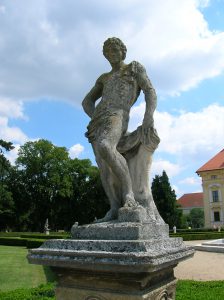 There is also a 30-minute multimedia projection depicting a virtual Battle of Austerlitz. The lovely 15-hectare Baroque park includes a splendid fountain and Baroque statues of mythological figures.
There is also a 30-minute multimedia projection depicting a virtual Battle of Austerlitz. The lovely 15-hectare Baroque park includes a splendid fountain and Baroque statues of mythological figures.
The town of Slavkov
The main square is picturesque with buildings painted in cheerful colors. Sights in town include a late Renaissance town hall and mansion as well as parts of the old town wall. The Classicist Church of the Resurrection of the Lord has three pulpits. The tombs of the Kounic family are located under the Church of Saint John the Baptist. A 19th-century synagogue is the sole reminder of a former Jewish settlement that began in 1294.




